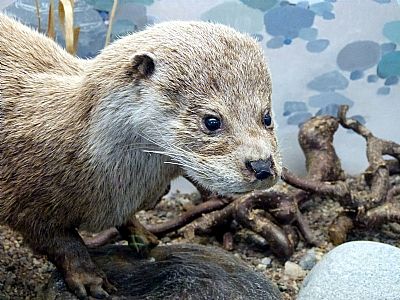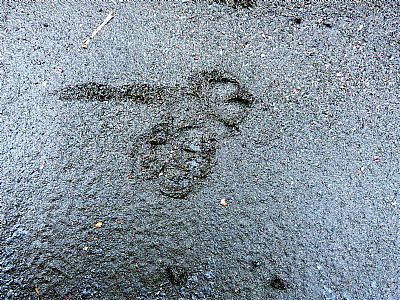OTTERS : Lutra lutra
You are very lucky if you see an otter within West Dunbartonshire. But they are around. Where was my camera when one came up the Leven and lolled around near the barrage a few years ago? It casually took great interest in the group of people and a few dogs that gathered to gawk at it; diving and coming up again repeatedly quite close to the shore. [Not to be confused with MINK].
Usually though they are very elusive. Regular early walkers sometimes see them. Reports of them in mid-April 2025 suggested a pair with kits. (This writer had a fleeting glimpse of one just down from the barrage and others had taken a photo of one near there too). They are carnivores that eat fish such as trout, carp and eels. They also happily eat amphibians, crustaceans and waterbirds like moorhens and coots too. Sometimes they will look for food on land, selecting birds, eggs, insects and small mammals to satisfy their appetite. While most of us are enchanted when we see them, fishermen can consider them in competition.
You may notice their sweet-smelling spraint. That refers to its droppings which may be the only signs of their activities. Sometimes though you may see their footprints. Otter tracks can be found in mud and sand close to water. They are 40-80 mm across and show four or five toes. The claw marks are usually not present, but sometimes the webbing can be seen between the toes. [Mammal Society].

Even when seen, they may be diving or you may get only a fleeting glimpse. We have therefore resorted to a museum specimen. [Rothesay]

Perhaps your first sign of otters. These are the footprints of an otter in the mud on the roadway just alongside the railings at the barrage. Seen in mid April very close to brief visual sightings in the water. That drag mark was replicated with each pair of prints along several meters. It appears that the otter was bounding along with its hind feet overlapping the front feet prints. The drag mark could have been its tail, but because it was not always directly in line, perhaps a large fish being carried along.
The Woodland Trust describe otters as having a playful nature and making a comeback in waterside woodland. This means that you do not have to seek them out only along the shores of our nothern islands, but may perhaps, just perhaps, see them locally. The Trust's website also gives some useful tips on how to spot them.
Otters are most active at night, so dawn and dusk are good times to look out for them. Look for otter tracks in mud and sand close to the water. Their spraints are a greenish, black-grey colour and full of evidence of their diet: bones, shells, feathers and fur. They smell sweet and musky, like jasmine tea or laurel flowers. Watch out for water activity as they dive and the V-shaped wake behind them when they swim. On the water's surface, their head and back are barely visible - but you might just catch a glimpse of their powerful tail as they dive below in search of food.
Beavers were reintroduced to Loch Lomond in early 2023. This included a family with kits (young). Two of the kits died, suspected of being killed by otters. While otters do eat small mammals, in this case they may simply have felt challenged by these new creatures in their terrain.
An alternative : While not the same species, you can see otters close up at the Loch Lomond Sealife Centre at Lomond Shores. These are Asian Short Clawed Otters. (It is not permitted to keep native otters in captivity).
Pic - Adobe stock images.
MAMMAL SOCIETY : https://mammal.org.uk/british-mammals/otter
NATURE SCOT : https://www.nature.scot/plants-animals-and-fungi/mammals/land-mammals/otter
SCOTTISH WILDLIFE TRUST : https://scottishwildlifetrust.org.uk/species/otter/
WOODLAND TRUST : https://www.woodlandtrust.org.uk/trees-woods-and-wildlife/animals/mammals/otter/

